while WE slept: bonds are BID as MOFCOM (China)disappoints; watch the FRIs; 'US Bond Yields Nearing ‘Alert Level’ For Stocks' -Amundi and more ...
Good morning …
JPOW walked a very tight rope as he attempted to convince the reporters in the room to convince the rest of us that while the economy was strong, rates were still too high, needed to come down AND the Fed is NOT on any preset course (ie, reminding the room the Fed retains optionality and drives the conversation and the markets and it’s NOT the other way ‘round) …
By the end of the day, the CMEs FedWatch tool has greater odds of another CUT in DECEMBER and increasing chances of a Jan 2025 pause.
I USED to care about ALL the nuance but now, well … I just don’t have to.
Debate(s) will rage about fiscal and economic policy being set by those in the ivory tower and what I can say with some amount of confidence is that price action is never wrong as it reflects the putting of ones money where their mouths are … and 2s HELD / holding TLINE.
Other securities are doing much the same. So in other words, TLINES and momentum being overbought or oversold are still worthy and will then continue to be on the ‘radar screen’.
THAT said, a look at 10s …
10yy DAILY: TLINES and momentum = BID
10yy WEEKLY for some further context where 4.00% appears on the ‘radar screen’
… and so it goes. Fed is CUTTING — whether or not they need to (again, recall just yest the idea of double defaults) and year end upon us.
60/40 STILL not dead.
Fed is cutting rates generally speaking bonds, then should NOT ‘suck’.
Whatever we think they think they think NOW, today, about DECEMBER or January can and will likely change several times but … as meetings grow closer, the Fed rarely offsides the markets so we’ll continue to watch the CMEs FedWatch tool as it, also, reflecting probabilities based on folks putting their money where their mouths are.
For NOW, though …
CNBC: Traders see good chance the Fed cuts again in December then skips in January
Expectations for a December interest rate cut remained strong after the Federal Reserve trimmed rates by a quarter percentage point in November.
On Thursday afternoon, the U.S. central bank lowered the federal funds rate to a target range of 4.5% to 4.75%.
… And now, off the soapbox and TO a couple links and the rest of the story … First …
ZH: Fed Cuts Rates By 25bps As Expected, Says Inflation/Labor Goals 'Roughly In Balance'
WolfST: Fed Cuts by 25 Basis Points, to 4.75% Top of Range, as Telegraphed to Backpedal from Monster Cut. QT Continues
… surprised? Me either and not just ‘cuz of, you know, double defaults and / or that 2s HELD / holding TLINE.
Now, while NOT surprised that the FOMC cut yesterday, I could have sworn he left the door open to a PAUSE …
… In assessing the appropriate stance of monetary policy, the Committee will continue to monitor the implications of incoming information for the economic outlook. The Committee would be prepared to adjust the stance of monetary policy as appropriate if risks emerge that could impede the attainment of the Committee’s goals. The Committee’s assessments will take into account a wide range of information, including readings on labor market conditions, inflation pressures and inflation expectations, and financial and international developments…
Transcript of Chair Powell’s Press Conference Opening Statement
… Recent indicators suggest that economic activity has continued to expand at a solid pace. GDP rose at an annual rate of 2.8 percent in the third quarter, about the same pace as in the second quarter. Growth of consumer spending has remained resilient, and investment in equipment and intangibles has strengthened. In contrast, activity in the housing sector has been weak. Overall, improving supply conditions have supported the strong performance of the U.S. economy over the past year.
In the labor market, conditions remain solid…
Inflation has eased significantly over the past two years…
We are not on any preset course. We will continue to make our decisions meeting by meeting.
As the economy evolves, monetary policy will adjust in order to best promote our maximum employment and price stability goals. If the economy remains strong and inflation is not sustainably moving toward 2 percent, we can dial back policy restraint more slowly. If the labor market were to weaken unexpectedly or inflation were to fall more quickly than anticipated, we can move more quickly. Policy is well positioned to deal with the risks and uncertainties that we face in pursuing both sides of our dual mandate…
… here is a snapshot OF USTs as of 627a:
… and for some MORE of the news you might be able to use…
IGMs Press Picks: November 8 th 2024
NEWSQUAWK: US Market Open: China-related assets slide as MOFCOM disappoints … Bonds are on a firmer footing, with modest outperformance in Gilts and as USTs await Fed speak from Bowman & Musalem … USTs are in the green, as markets digest the 25bps move from the Fed and continued data-dependent and meeting-by-meeting guidance alongside Powell saying he intends to serve the entirety of his term (mid-2026). Given the cut, yields are lower across the curve though there is no overt flattening/steepening bias currently. USTs at a 110-16+ peak, just off the 110-21+ WTD high. No real follow through from the underwhelming Chinese press conference.
PiQ Overnight News Roundup: Nov 08, 2024
Opening Bell Daily: Powell says no
Reuters Morning Bid: Post-election Wall St booms as Fed cuts, China spurs
Finviz (for everything else I might have overlooked …)
Moving from some of the news to some of THE VIEWS you might be able to use… here’s SOME of what Global Wall St is sayin’ …
BARCAP: November FOMC: Keeping all options open for December
The FOMC lowered rates 25bp today. Powell suggested more cuts are likely and that a December cut will be data-dependent. We retain our baseline projection that the FOMC will lower rates 25bp in December, with rising risks of a pause. We now think the FOMC will cut by 25bp only twice in 2025, to 3.75-4.00%.
… For 2025, in light of the outcome of the US elections and the likely implementation of import tariffs and tighter restrictions on immigration, we raised our inflation projections and lowered our GDP growth outlook. We now think the FOMC will cut by 25bp only twice in 2025, to 3.75-4.00%. We expect rate cuts to resume around mid-2026, with the FOMC delivering another two 25bp cuts after tariff-led inflation pressures dissipate.
BARCAP: US Outlook & FOMC Update: The tariff is back in town
We raise our inflation projections and lower GDP growth in 2025-26 due to the likely implementation of import tariffs and tighter immigration restrictions. Accordingly, we revise up our policy rate path. We now think the FOMC will cut rates only twice next year, by 25bp in March and June, and twice again in 2026.
BARCAP: US CPI Inflation Preview (October 2024 CPI): Limited relief
We forecast core CPI inflation of 0.30% m/m (3.3% y/y) in October, showing limited relief from September. We look for another month of strong core goods inflation and expect only modest core services disinflation. We expect headline CPI of 0.2% m/m SA (2.6% y/y) and forecast the NSA print at 315.579.
BARCAP: Food for Thought: Trump 2.0
Across SPX, SPW, NDX, RTY, large-cap Value and Growth, and SPX ex-Big Tech, the reactions to Trump's election win were directionally consistent with 2016 but of a larger magnitude. Markets appear hopeful for a domestic growth boost (small-caps) and deregulation vs. Biden (stronger bids for NDX, Big Tech, Financials).
BNP: US November FOMC: Lower bar to a skip in December
KEY MESSAGES
We think a Fed rate cut is still more probable than not in December, after a widely anticipated 25bp move on 7 November.
Chair Powell laid out an upbeat picture for the US economy, alongside a confident assessment of progress on the inflation front.
We believe realized economic data will need to line up more firmly to support a December skip, but the political backdrop – which includes potential for a more inflationary mix of policy – will lower the bar.
DB: FOMC recap: Don't hurry, Fed happy
As expected, the Fed delivered a 25bp cut and provided limited forward guidance about the policy path ahead. However, the overall tone of the meeting leaned slightly hawkish, as Powell noted that recent data have diminished downside risks to the economy and that the Committee is in no hurry to get to neutral.
Our baseline remains that the Fed delivers another 25bp reduction in December, but the bar for a skip at that meeting is not high. Today's meeting certainly left open this possibility. While Powell emphasized that the election outcome will not impact "near term" policy decisions, we anticipate that upcoming changes to fiscal and trade policy could ultimately push the Fed in a hawkish direction over the next year, with the fed funds rate possibly staying above 4% (see Fiscal fuel trumps trade tensions for Fed ).
DB: Tough not to sound hawkish
Like our US economics team, we think in the immediate wake of the election Powell will look to play it down the middle today, simply noting the FOMC will adjust policy as appropriate and studiously avoid engaging in hypotheticals. Some version of this line from the FOMC statement should pop up more than once: “In considering additional adjustments to the target range for the federal funds rate, the Committee will carefully assess incoming data, the evolving outlook, and the balance of risks.”
But, to the extent we get clues on Powell's and the Committee’s leanings, they should be hawkish. There are three main reasons: (1) the September SEP showed a Committee already closely divided on one vs. two more cuts this year, (2) financial conditions have eased notably since then, to their most accommodative levels of the cycle, and (3) US economic data has surprised to the upside over this period.
ING: The Fed cuts by 25bp, and hints at more gradual cuts in the future
The US Fed has cut its policy rate by 25bp. They acknowledge that policy remains restrictive and that further cuts are likely but that the pace of those cuts may slow. They were reluctant to discuss the 'Trump effect', but here's the risk: slightly firmer growth with more inflationary pressures. And that might lead to a less aggressive rate-cut narrative
…Fed funds ceiling rate with duration between last hike in a cycle and first rate cut
ING: China announces huge debt package ahead of 'forceful' stimulus
China has unveiled a RMB10tn programme to alleviate local government debt issues. The package, worth some $1.4tn, was announced after the week-long National People's Congress
JPM: Flows & Liquidity
Watch the US FRIs
06 November 2024
We use our Forecast Revision Indices (FRIs) to provide a framework on how US economic surprises under a second Trump presidency would impact markets
We continue to see room for the Trump trade to reverberate over the coming eight weeks or so in a similar fashion to 2016.
Gold and bitcoin should both benefit from a second Trump presidency. Bitcoin to get an extra boost from MicroStrategy’s massive bitcoin purchase program.
The recent sharp narrowing of swap spreads in both the US and Europe is a reminder of the rising “inconvenience” of government bonds.
…Outside the reverberations over the coming weeks, over the longer term the Trump win is likely to reinforce the so called US exceptionalism. We argued previously that US exceptionalism has two main manifestations: the dominant position of US equities and the outperformance of the US economy. The first has been reflected in the rising share of US equities in global equity markets (Figure 2). The latter has been reflected in the striking divergence between economic growth surprises in the US vs. the rest of the world. This is shown by Figure 3 which depicts our Forecast Revision Index (FRI) for US GDP vs Global GDP. This US economic outperformance had also been a feature in the first Trump presidency when tariffs hit during 2028/2019 (Figure 4). With US tariffs potentially hitting the rest of the world earlier in the second Trump presidency, perhaps as soon as early next year, the current US economic outperformance could spill over into 2025. In turn this raises the question: how would US economic surprises impact markets?
To answer this question we look at the experience over the past five years which in our opinion sheds some light on the relationship between US economic surprises and markets. The S&P500 index has been tracking our US FRI rather closely as shown in Figure 5Forecast RvionIdex forUSGDP vstheS&P50 index. As a result to the extent the Trump win sustains the upward trajectory in US economic growth surprises, the bull equity market would continue …
NWM: US: Recap of November 6-7 FOMC meeting
As expected, the FOMC cut the funds target by 25bps to 4.50-4.75%
Statement showed only a few minor changes
Powell bit more positive. Reiterated policy not on preset course/meeting-to-meeting
RBC: Future Fed policy decisions still data dependent after 25 bp cut
The Bottom Line:
The 25 basis point Fed rate cut today was widely expected. The economic backdrop has been too resilient, and inflation too sticky, to justify a repeat of the (larger than "normal") 50 basis point initial cut in September but labour markets have shown enough, albeit very gradual, signs of cooling to argue that interest rates are still higher than they need to be to get inflation back fully to the 2% objective.
The Fed continues to signal that more interest rate cuts are likely coming, but the timing (and end destination) remain uncertain. Our own base-case assumption remains two additional 25 basis point cuts from the Fed in December and January before pausing at a 4% to 4.25% range for the rest of 2025 with interest rates needing to stay at relatively high level to offset the inflationary impact of an unusually large government budget deficit.
UBS: Why inflation may not stop tariffs
Voters’ perceptions of inflation were important in the recent US elections. The economy was the top concern for Republican voters, and three quarters of US voters felt inflation created hardship for them this year. That negative perception outweighed the benign reality.
US President-elect Trump has talked repeatedly about raising tariffs. These taxes will be paid by US buyers of imported goods, and as these are passed down the supply chain, they will raise domestic US inflation. Despite the political power of inflation, there are two reasons such an increase in US prices may not prevent tariffs.
Tariffs are applied at the point of import. All subsequent costs (retail, wholesale, transport, etc.) are not subject to the tariff. Thus, a 20% tariff on a finished consumer good should raise its price around 8% in the store. Tariffs are less visible to consumers, and some impact may be absorbed by squeezing profits along supply chains.
Tariffs generally apply to lower-frequency purchases like consumer durable goods. Consumers are less aware of the price of these goods; inflation perceptions are formed by hyper-awareness of the price of frequent purchases like food and fuel (less likely to be imported). Tariffs may end up raising inflation with less impact on the politically important perception of inflation.
Wells Fargo: Fed Continues To Dial Back Policy Restraint via 25 bps Rate Cut
Summary
As widely expected, the FOMC cut rates by 25 bps at today's policy meeting. The decision was unanimous.
The Committee noted that progress has been made in returning inflation to its target of 2% and that the risks of achieving its goals of price stability and full employment are roughly balanced.
Despite 75 bps of rate cuts since the September 18 policy meeting, the stance of monetary policy remains restrictive. That is, the real fed funds rate remains above most estimates of "neutral." Therefore, we look for the FOMC to ease policy further at upcoming meetings.
In our view, the FOMC will not react to potential policy changes that could be implemented by the incoming Trump administration until those policies are more fully formed. If, however, tariffs or other fiscal policies were to cause inflation to move higher next year, then we believe the nominal fed funds rate would not fall all the way toward 3%, as we had forecasted prior to the election.
Wells Fargo: October CPI Preview: Disinflation Is Getting Harder
Summary
The October Consumer Price Index will likely show that progress in wringing out the last bit of inflation remains frustratingly slow. We look for headline CPI to have advanced 0.2% in October, which would bump up the 12-month change in consumer prices to 2.5%. Excluding food and energy, prices are likely to have increased 0.3% for a third consecutive month as another increase in goods prices coincides with glacial easing in services inflation.Yardeni: Powell's Mixed Message Remains Dovish
…We were surprised that the vote to cut the FFR was unanimous today. Governor Michelle Bowman dissented in the September 18 FOMC meeting. Powell acknowledged that the economic numbers since then have been stronger than expected. One might question why an additional rate cut was needed if the economy is in fact in better shape today than it was at the Fed's last meeting? What's the rush, if there is supposed to be no rush…
…The 10-year Treasury bond yield fell more than 10bps today, reversing some of yesterday's rise. The question is whether the bond market will continue to tighten credit conditions as it has since the September 18 FFR cut.
Powell was asked a couple of times about the backup in bond yields. He explained that the 75bps rise in Treasury yields since the FOMC cut the FFR by 50bps was mostly a result of stronger economic growth and diminished recession risk. He minimized the impact of higher inflation expectations. But the market's inflation expectations, based on the difference between nominal Treasury yields and TIPS yields, have risen…
… And from Global Wall Street inbox TO the WWW …
Bloomberg: Amundi CIO Sees US Bond Yields Nearing ‘Alert Level’ For Stocks
Trump’s inflationary policies could push US yields higher
Europe’s largest asset manager set to take profit on US stocks
… “I think that the real alert level, one that can have a real impact, is 5%, and I think we can get there quite quickly,” said Vincent Mortier, noting how yields on US 10-year Treasury bonds had surged after Donald Trump won the US presidential race …
… The US equity-risk premium, or the excess return that investing in the stock market provides over the risk-free rate, has fallen to its lowest level in more than 22 years, and is settling in negative territory, meaning stocks are objectively already less attractive than bonds.
The US equity market is also getting very expensive. The S&P 500 is now trading at 22.5 times forward earnings, well above a long-term average of about 16 times.
The gap in attractiveness between bonds and strocks could widen further, Mortier said, citing a recent note by Goldman Sachs strategists that argued US stocks are unlikely to sustain their above-average performance of the past decade.
McClellan: New York Rain and Stocks - - Silly, But Accurate - Chart In Focus
November 07, 2024
Watching the rainfall data for New York City and its relationship to the stock market is one of the funnier relationships I have discovered in the few decades I have been doing this. There is no reason I can think of for why such a relationship should exist, and yet there is a large amount of evidence showing that the two are related.
It is a coincident relationship, not a leading one, so it is not like we can watch what the New York City rainfall does, and make conclusions about what the stock market will do. But if New York is heading into a drought, as the El Niño and La Niña cycle flips, then that could have lasting implications…
… Now, in case you are thinking that this is just some spurious recent correlation, here is the same comparison from a century ago.
Notice how there was a big drought in New York City lasting for the entire period of the worst bear market of all time. And once the rains returned in a big way starting in 1933, so did the gains for stock prices. And the Fed seems to have thwarted the 1924-25 drought's effects on stock prices, thanks to three half-point cuts in the Discount Rate in May, June, and August 1924 which helped lift stock prices…
… AND …
Donald Trump Wins The Election! Will Jerome Powell Steal the Spotlight?
… THAT is all for now. Off to the day job…







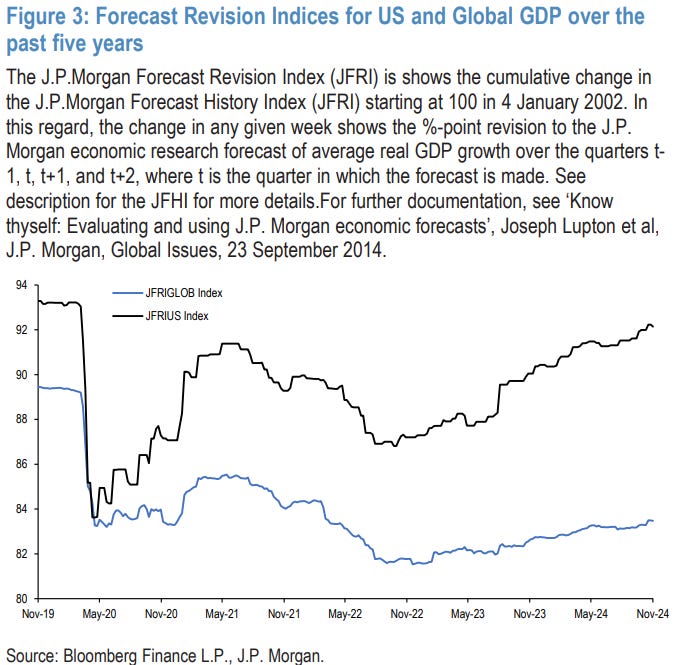

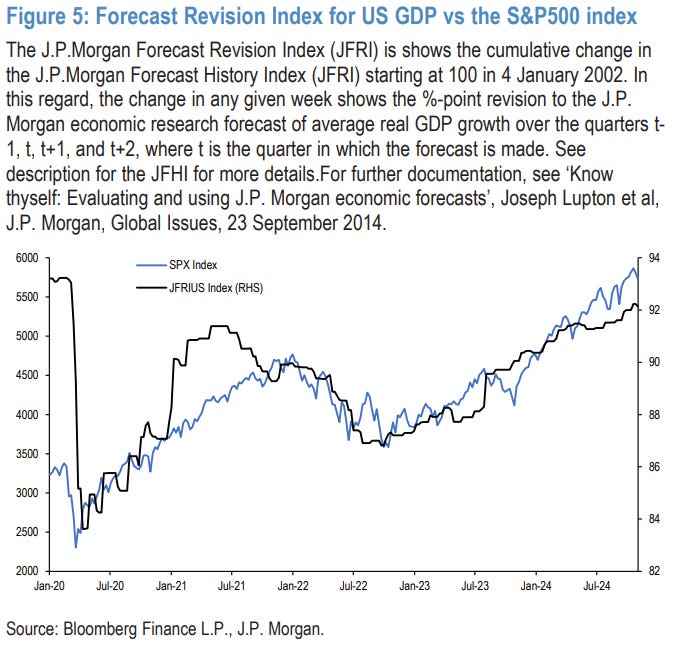
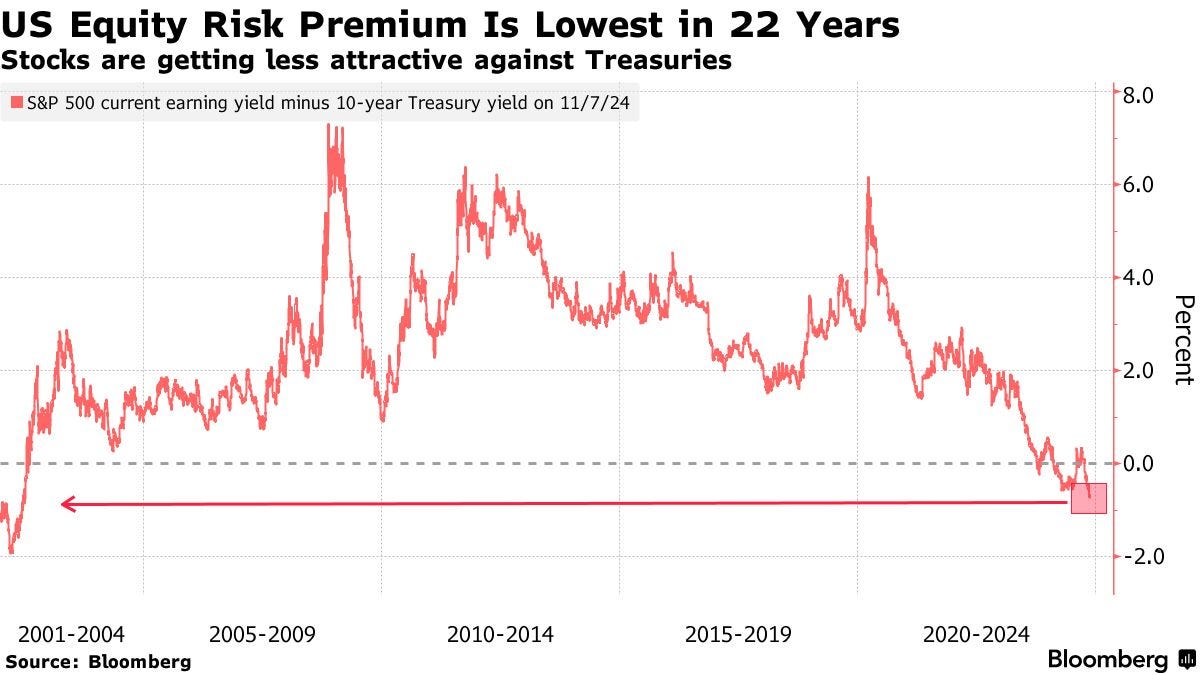
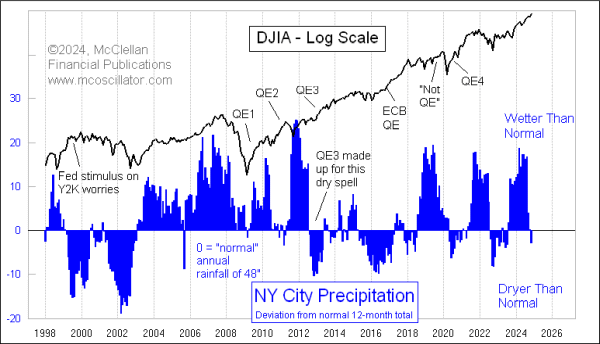
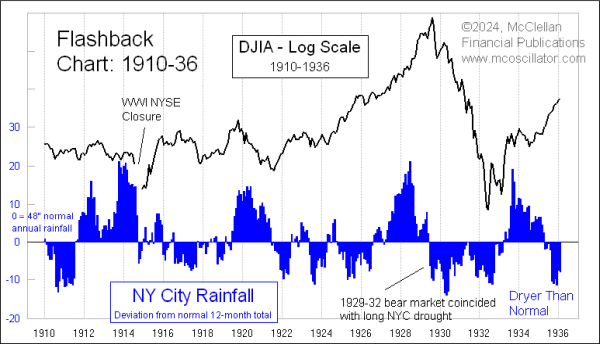
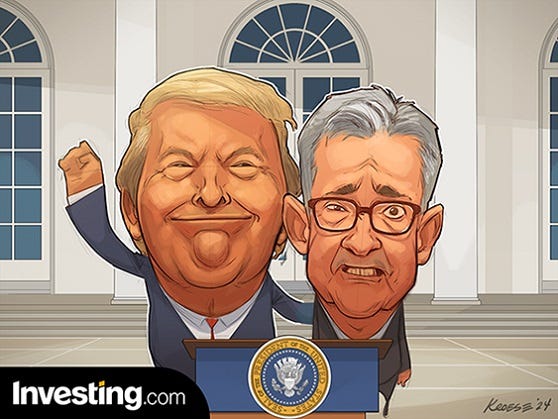
https://youtu.be/DAYSDy03Slw?si=ghYcg5T9w5jqnCQd
Gundlach: Consequential Voters. Inconsequential Fed
very good round up on FOMC. Thanks and have a nice weekend